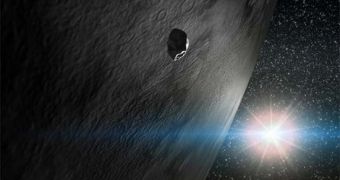In a groundbreaking new study, researchers have discovered the existence of water ice on an asteroid for the second time, hinting at the fact that the stuff is a lot more common on space rocks than thought.
Scientists now believe that a large number of asteroids or meteorites may carry at least trace amounts of water ice, a departure from the original view stating that there bodies were just barren rocks.
Asteroid 65 Cybele was analyzed by two research teams, that individually came to the same conclusion. The finding comes only 6 months after the first one, which was made on 24 Themis.
Such conclusions basically support the theory stating that water arrived on Earth via space rocks, and that it is not endemic to our planet. Discoveries such as this one certain support this view.
The space rock that made the object of the study orbits the Sun between Mars and Jupiter, and has a rough diameter of about 180 miles, or 290 kilometers.
In order to get more details of its surface, the investigators analyzed the light bouncing off its surface with a spectrograph. This instrument can detect the unique “light fingerprint” of all chemicals.
“This discovery suggests that this region of our solar system contains more water ice than anticipated,” said in a statement University of Central Florida expert Humberto Campins.
“And it supports the theory that asteroids may have hit Earth and brought our planet its water and the building blocks for life to form and evolve here,” he added further.
For the new work, the team used the Infrared Telescope Facility on Mauna Kea, in Hawaii, and the NASA Spitzer Space Telescope, both of which survey the sky in infrared wavelengths.
In addition to water ice, the investigation also revealed the existence of complex organic solids on the surface of the asteroid. But experts say that the ice layer covering 65 Cybele is rather thin.
Data from the two observatories indicate the presence of an ice layer just one micron thick. However, the real question is where did this ice originate in the first place.
Campins and his group detailed their work on October 8 in Pasadena, California, at the 42nd annual meeting of the American Astronomical Society's Division for Planetary Sciences, Space reports.
The expert said that, if the water ice came from within the asteroid, then this would be a sign that the stuff was with the space rock since it first formed, billions of years ago.
However, that is only speculation at this point, Campins concedes. The new study has already been accepted for publication in an upcoming issue of the journal Astronomy and Astrophysics.

 14 DAY TRIAL //
14 DAY TRIAL //